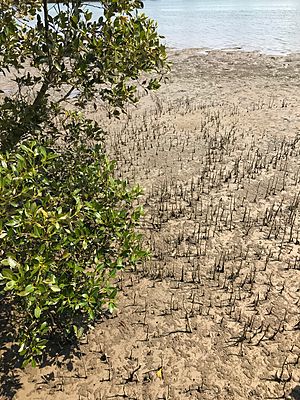Australian mangroves facts for kids
Australia is home to amazing mangrove forests! These special trees and shrubs grow in salty water along the coasts, especially in tropical and subtropical areas. You can find them in places like rivers, estuaries (where rivers meet the sea), and bays. Australia has about 11,500 square kilometers of mangroves, mostly on its northern and eastern sides. That's a huge area, but it's less than 1% of all Australia's forests.

Even though mangroves love warm places, some can be found surprisingly far south. For example, there are mangroves in Victoria and South Australia. Nearly half of Australia's mangroves are in Queensland (44%), followed by the Northern Territory (37%) and Western Australia (17%). In Western Australia, some mangroves are found very far from others, like those near Bunbury. This might be because their seeds traveled there on ocean currents. The most inland mangroves in Australia are about 60 kilometers from the coast in the Mandora Marsh.
Contents
Mangrove Plants: Amazing Adaptations
Australia's mangrove forests have 45 different kinds of plants from 18 families. This is more than half of all the mangrove species in the world! One special tree, Avicennia integra, is found only in Australia, specifically east of Darwin in the Northern Territory.
Each type of mangrove tree likes certain conditions, like how far north or south it is, and how much the tide covers it. You'll find the most different kinds of mangroves in the far northern parts of Australia. For example, Darwin Harbour has 36 mangrove tree species, but Bunbury in the south has only one. There are no mangroves in Tasmania at all.
The most common mangrove tree in Australia is the grey mangrove, also known as the white mangrove (Avicennia marina).
Mangrove forests also have other plants that can handle salt. These include the mangrove palm (Nypa fruticans), the mangrove fern (Acrostichum speciosum), and orchids that grow on mangrove tree trunks. You might also see the mangrove lily (Crinum pedunculatum) nearby. Mangroves often grow next to saltmarshes, which are areas with other salt-loving plants.
Animals That Call Mangroves Home
Mangrove forests are like busy nurseries for many sea creatures. They are important breeding and feeding grounds for fish and crustaceans. This includes popular seafood like barramundi (Lates calcarifer), mangrove jack (Lutjanus argentimaculatus), mud crabs (Scylla serrata), and banana prawns (Penaeus merguinensis). Oysters also settle and grow here.
Many land animals also use mangroves for food, shelter, and raising their young. You can find insects, reptiles, frogs, birds, and even mammals living in these forests.
Some interesting animals found here include the rusty monitor (Varanus semiremex), which hides in hollow mangrove trees in Queensland. The mangrove snake (Fordonia leucobalia) and the huge estuarine crocodile (Crocodylus porosus) live in northern mangrove forests.
Birds love mangroves too! The lesser noddy (Anous tenuirostris melanops), a type of seabird, builds its nest in mangrove trees. This bird is considered vulnerable, meaning it needs protection. Many small insect-eating birds also live in mangroves, such as various honeyeaters, flycatchers, and whistlers. Other birds like kingfishers and fruit-doves also visit these forests.
Flying foxes sometimes use mangrove forests as nursery areas, especially in Darwin Harbour. Some species, like the little red flying fox, even rely on mangrove pollen for food.
Why Mangroves Are Super Important
Mangroves do a lot of good things for our planet and for people!
Protecting Our Coasts
The huge root systems of mangroves are amazing at protecting coastal areas. They can slow down strong waves from storms and even tsunamis. This helps stop the land from washing away (erosion). Mangroves also slow down the tide, which allows mud and sand to settle. This helps them build up their own environment over time.
Helping Fishing Industries
The fishing industry, both for commercial businesses and for people fishing for fun, gets a lot of help from mangroves. These forests provide safe places for fish and prawns to breed and grow. In Queensland, about 75% of the fish and prawns caught spend at least part of their lives in mangroves.
Eco-Tourism and Education
In some coastal towns, special boardwalks and bird-watching spots are built in mangrove forests. These areas attract tourists who want to see nature up close. This helps the eco-tourism industry and also teaches people about how important mangroves are, like at Boondall Wetlands.
Threats to Mangrove Forests
Sadly, mangrove ecosystems face several dangers:
- Coastal Changes: People sometimes remove mangroves to build things like houses, canals, or marinas.
- Erosion: Shorelines in coastal lakes and estuaries can erode, harming mangroves.
- Pollution from Land: When land is cleared for farming or building, extra nutrients and dirt can wash into the water, harming mangroves.
- Chemical Pollution: High levels of heavy metals (like copper, lead, and mercury) and chemicals from boat paints can pollute the water.
- Oil Pollution: Oil from sewage systems and drains, and accidental spills from ships, can damage mangroves.
When mangrove forests are removed, it can lead to more erosion along the coast. It can also expose harmful acid sulphate soils, make waterways shallower, and reduce water quality. These threats can cause the populations of fish, prawns, and crabs to drop, which then hurts the fishing industry.
Protecting and Saving Mangroves
It's important to protect Australia's mangroves. About one-third of all mangrove forests in Australia are privately owned, including some Indigenous reserves. Around 18% of Australia's mangroves are protected in National Parks and other special reserves.
Mangroves are protected by laws in Queensland (Fisheries Act 1994) and Western Australia (Wildlife Conservation Act 1950). As more people learn about how valuable mangroves are, local groups are working harder to protect them. Boardwalks in mangrove areas are a great way to teach people about their ecological and economic importance.
See Also


